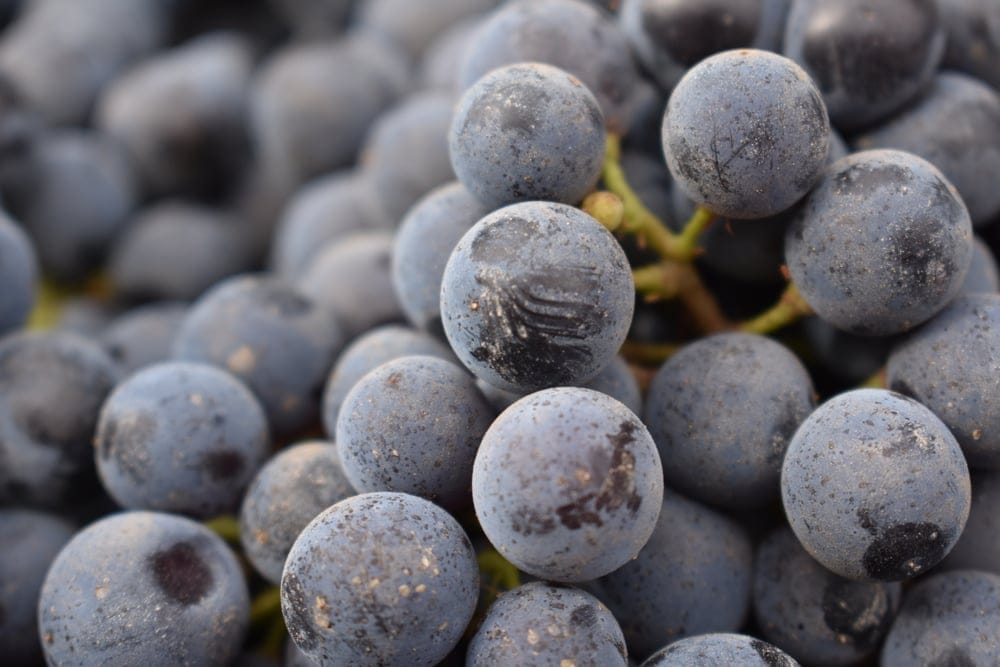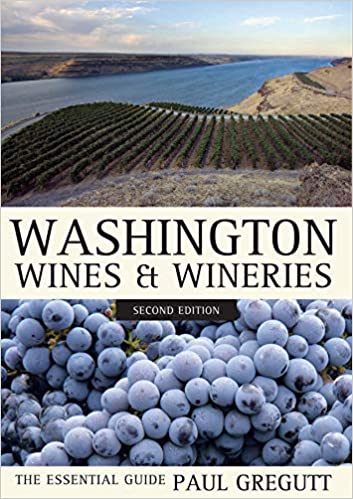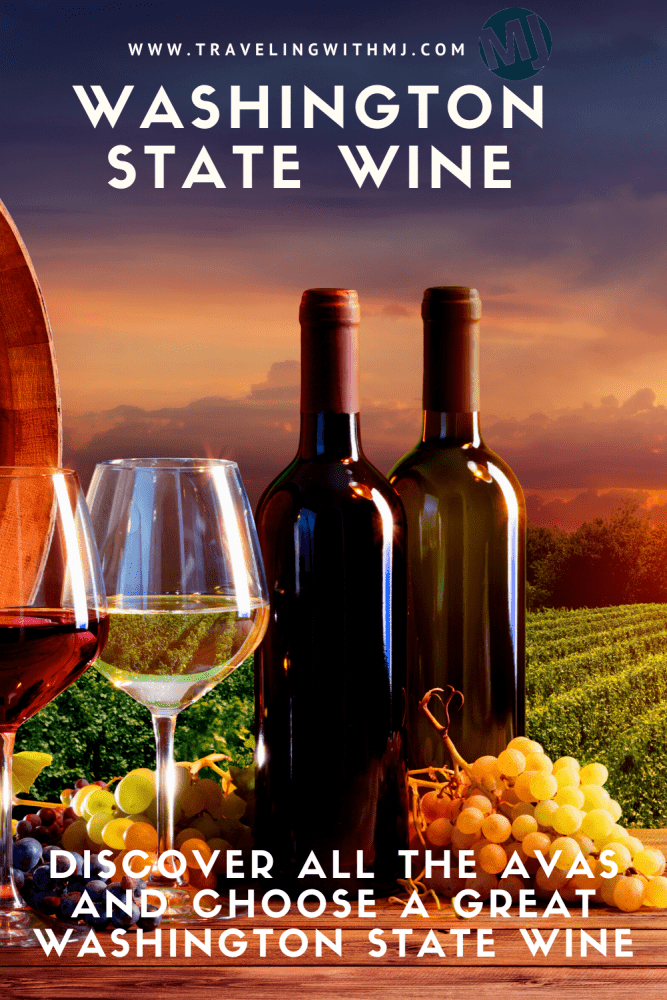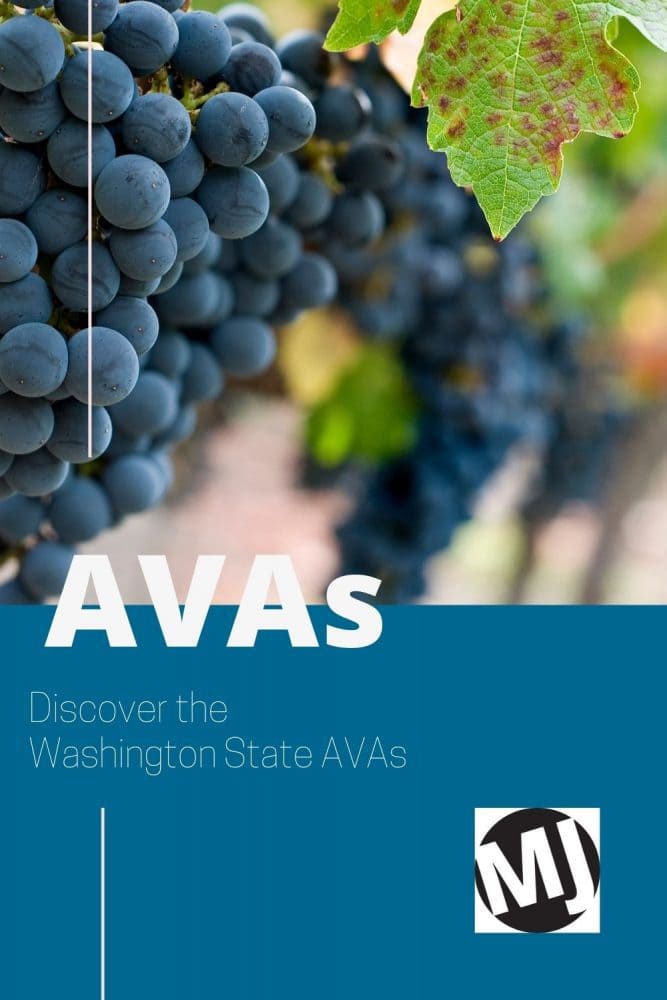Washington State wine is sold in all 50 US states as well as in over 40 countries around the world. Chances are, you’ve seen a Washington wine on a wine list pretty much anywhere you’ve traveled. Learn all about the Washington wine industry and the Washington State AVAs (wine regions) that produce these delicious and award-winning wines.

Washington is the second-largest wine region in the United States, trailing California. (Oregon comes in third.) The climate creates a near-perfect environment for the acres of vines growing grapes for both red wine and white wine. Washington wines are solid performers at wine competitions, flashing their signature crisp acidity and fruit-forward flavors that win accolades in reputable wine competitions. Additionally, Washington is home to forward-thinking, sustainability-conscious vineyards and wineries.
So let’s dig in and learn more about the Washington State AVAs .
- What are AVAs?
- The 16 AVAs in Washington State
- 1. Columbia Valley AVA
- 2. Ancient Lakes AVA
- 3. Walla Walla Valley AVA
- 4. Wahluke Slopes AVA
- 5. Royal Slope AVA
- 6. Horse Heaven Hills
- 7. Lake Chelan AVA
- 8. Naches Heights AVA
- 9. Yakima Valley AVA
- 10. Candy Mountain AVA
- 11. Rattlesnake Hills AVA
- 12. Red Mountain AVA
- 13. Snipes Mountain AVA
- 14. Puget Sound AVA
- 15. Columbia Gorge AVA
- 16. Lewis-Clark Valley AVA
- Recommended Reading:
- 3 Proposed AVAs in Washington State
- Choosing a Winery and AVA
What are AVAs?
An American Viticultural Area (AVA) refers to a geographically grape-growing region that is distinct from surrounding regions. The Alcohol and Tobacco Tax and Trade Bureau (TTB) determines these regions, but requests are driven by wineries and other wine industry stakeholders.
The 16 AVAs in Washington State
Currently, there are 16 AVAs in the State of Washington. Top-producing grapes include Riesling, Chardonnay, Cabernet Sauvignon, Merlot, and Syrah, but Washington State boasts a little bit of everything.
Let’s dig in to the 16 AVAs in Washington.
1. Columbia Valley AVA
Established: 1984. IThe Columbia Valley AVA is a mega AVA that contains all the other sub-appellations in Washington except for Puget Sound, Lewis-Clark Valley, and Columbia Gorge.
Where: Central, south-central, and southeastern Washington. Lies to the West of the Cascade Mountains in the Columbia River Plateau. It’s a cross-border AVA with some of its growing regions overlapping into Oregon.
History: Settlers in the early 1900s planted the first vineyards on the Oregon side. In the 1970-80s, it was known for Riesling and Gewürztraminer.
Grapes: Cabernet Sauvignon is the most prominent grape variety in this region. Merlot, Chardonnay, Syrah, Riesling, Pinot Gris, and Sauvignon blanc round out the top producers. More than 30 grape varieties are planted here. The weather in the AVA results in fruit-forward wines similar to what is found in California.
Of note: The Columbia Valley AVA accounts for 99% of the wine-growing acreage in Washington State, and is the largest viticultural area in Washington, covering more than a third of the state landmass.
Wineries: 53 (this total excludes wineries found in the other AVAs located within Columbia Valley)
2. Ancient Lakes AVA
Established: October 18th, 2012
Where: Central Washington. Near Quincy, Washington, between Beezley Hills and Frenchman Hills. It’s about a two-and-a-half-hour drive from Seattle to Quincy. Ancient Lakes is a sub-appellation of the Columbia Valley AVA.
History: This AVA was named for a chain of over 30 lakes scattered throughout the Columbian Basin. Wine grapes were planted in this region as early as the 1980s, with most vineyards predominantly growing white grapes.
Grapes: The main white varieties grown in the Ancient Lakes AVA are Chardonnay, Pinot Gris, and Riesling. Red wines are represented to a much lesser extent, although grapes used in rosé are grown at lower altitudes along the Columbia River.
Of note:
Wineries: 6
3. Walla Walla Valley AVA
Established: 1984. The Walla Walla Valley AVA is a sub-appellation of the Columbia Valley AVA and overlaps into neighboring Oregon.
Where: The AVA is situated in southeastern Washington and crosses into Oregon. Its eastern border touches the base of the Blue Mountains. Walla Walla is just over a four-hour drive from Seattle.
History: The name Walla Walla comes from the Native American word for “many waters.” Italian immigrants planted the first vines in the Walla Walla Valley in the 1850s.
Grapes: Red varieties dominate this region, with Cabernet Sauvignon leading the way. Other popular varieties are Merlot, Cabernet Franc, Syrah, Pinot Noir, and Malbec. Walla Walla is well known for producing savory Syrahs, a favorite choice in the region. White varieties include Chardonnay, Sauvignon Blanc, Riesling, Viognier, Gewürztraminer, and Pinot Gris.
Of note: This AVA has the highest concentration of wineries in the state, making it a Walla Walla a popular choice for weekend wine tasting.
Wineries: 140
4. Wahluke Slopes AVA
Established: 2006. The Wahluke Slopes AVA is wholly contained within the Columbia Valley AVA.
Where: South-central Washington near the town of Mattawa to the west of the Hanford Reach National Monument. The Columbia River marks its borderline to the south and west, while the Saddle Mountains naturally define its north border. The town of Mattawa is a two-and-a-half-hour drive from Seattle.
Grapes: Red varieties dominate the Wahluke Slopes, with top varieties Merlot, Syrah, and Cabernet Sauvignon.The Cabernets from this region have distinct black cherry and cassis flavors, while Merlots reflect red fruit flavors. Some of the white grape varieties you can find here include Riesling, Chardonnay, and Chenin Blanc.
Of note: A wine made from Wahluke Slopes grapes was awarded the Wine of the Year in 2009 by Wine Spectator.
Wineries: 3
5. Royal Slope AVA
Established: 2020. It is entirely within the Columbia Valley AVA.
Where: Central Washington, between the Saddle Mountains and Quincy Basin with the town Royal City located within the AVA. The appellation is tucked between the Ancient Lakes AVA to the south and the Wahluke Slopes AVA to the north. Royal City is two and a half hours to the northwest of Seattle.
History: Vines were planted on the Royal Slopes for the first time in 1983.
Grapes: Today there are over 20 grape varieties in this appellation. The most common red varieties include Cabernet Franc, Cabernet Sauvignon, Malbec, Grenache, Merlot, Mourvèdre, Petit Verdot, Tempranillo, and Syrah. The white varieties in the Royal Slopes include Chardonnay, Chenin Blanc, Pinot Gris, Gewurztraminer, Riesling, Roussanne, Semillon, Sauvignon Blanc, and Viognier.
Interesting Factoid: The Royal Slope produces high-quality Syrah. It’s renowned for having produced Washington’s first 100-point Syrah (2006 Charles Smith “Royal City” Washington Syrah).
Wineries: 1
6. Horse Heaven Hills
Established: 2005. Horse Heaven Hills AVA is wholly contained within the larger Columbia Valley.
Where: Horse Heaven Hills is located in eastern Washington near the towns of Alderdale and Paterson. Alderdale is three and a half hours southeast of Seattle. The AVA runs along the border with Oregon, with a natural boundary of the Yakima Valley AVA on the north and the Columbia Valley on the south.
History: The earliest commercial vineyards were planted in Horse Heaven Hills in 1972, where Champoux Vineyard now stands.
Grapes: Two out of every three grapevines planted in this region are red grape varieties. There are more than 35 varieties that are planted in this region. The top red grape varieties in Horse Heaven Hills are Cabernet Sauvignon and Merlot. Riesling and Chardonnay share the lead when it comes to white grapes. Chardonnays here have a flavor of tropical fruits, while Rieslings’ flavor lean toward peach fruits.
Of note: The region produces a quarter of Washington’s grape harvest.
Wineries: 6
7. Lake Chelan AVA
Established: 2009. Lake Chelan AVA is a sub-appellation of the larger Columbia Valley AVA.
Where: Lake Chelan is a popular summer vacation destination and encompasses the towns of Chelan and Manson. The appellation lies in central Washington, just over 100 miles to the northeast of Seattle City.
History: Commercial vineyards were established here by Native Americans. Italian immigrants arrived early in the 20th century and establish vineyards. The first winery was established in1998.
Grapes: Red and white grapes are fairly even in this appellation. The main red varieties include Syrah, Merlot, Malbec, and Pinot Noir. The whites dominate this landscape are Riesling, Pinot Gris, Gewurztraminer, and Chardonnay. Plans are underway to introduce 20 more grape varieties.
Wineries: 27
8. Naches Heights AVA
Established: 2011. Naches Heights AVA is a sub-appellation of the larger Columbia Valley AVA.
Where: Central Washington in the Columbia Valley between the towns of Naches and Tieton. It’s situated northwest of Yakima and bounded by the Naches River, the Cowiche Creek, and the Tieton River.
History: Naches Heights has a relatively recent history, with the first grapes planted here in 2002. These were Pinot Gris, Riesling, and Syrah.
Grapes: Today, white grapes are the majority occupying 60% of the vineyards, with the reds at 40%. The white varieties that dominate this AVA are Semillon and Sauvignon blanc. The main red varieties in the Naches Height appellation are Cabernet Franc, Cabernet Sauvignon, Merlot, Malbec, and Petite Verdot.
Of note: This is the only wine-growing zone in Washington State that’s 100% sustainable. All the vineyards in this appellation are farmed organically or biodynamically and are salmon-safe.
Wineries: 1
9. Yakima Valley AVA
Established: 1983. Yakima Valley AVA is a sub-appellation of the huge Columbia Valley AVA. Yakima AVA has its own sub-appellations; Rattlesnake Hills, Red Mountain, Candy Mountain, and Snipes Mountain.
Where: South-central Washington. A vast area covering over 700,000 acres. Yakima is the main city in this AVA, a drive from Seattle of slightly over two hours.
History: Grape growing in the Yakima Valley began in 1917 but picked up pace in the early 1960s and 1970s. Yakima Valley was the first AVA in Washington State.
Grapes: Close to 40 distinct white and red grape varieties thrive across this viticultural region. The most planted grape in the region is Chardonnay, with Merlot and Carbenot Sauvignon following (in that order). Other popular grapes in the AVA include Riesling, Pinot Gris, Sauvignon Blanc, Cabernet Franc, Gewürztraminer, and Syrah. Syrah is notably gaining ground in this region.
Of note: The Yakima Valley AVA contains over a third of Washington’s vineyards.
Wineries: 113
10. Candy Mountain AVA
Established: September 25th, 2020. Candy Mountain AVA is a sub-appellation of the Yakima Valley AVA, which is within the great Columbia Valley AVA.
Where: South-central Washington. Near Richland City, about four miles to the southeast of Red Mountain. Richland City is three and a half hours from Seattle. The AVA stretches alongside a series of four mountains (including Red Mountain, Badger Mountain, and the Little Badger Mountain) jointly known as the “rattles” due to their location relative to Rattlesnake Mountain.
History: Candy Mountain Vineyard, the only winery in the AVA, was set up back in 1998. Candy Mountain is the newest of the Washington State AVAs.
Grapes: At the moment, almost all the grape grown in this AVA are reds.
Of note: Candy AVA is the smallest AVA in Washington at 815 acres, with 110 acres of vineyards.
Wineries: 1
11. Rattlesnake Hills AVA
Established: 2006. The Rattlesnake Hills AVA is a sub-appellation of the Yakima Valley AVA, which is contained within the larger Columbia Valley AVA.
Where: South-central Washington, around the town of Zillah about four miles south of Yakima and two and a half hours from Seattle. It’s sprawled throughout several hills that lie to the south of the Moxee Valley along the Yakima River.
History: This AVA is named after the Northern Pacific rattlesnake. Commercial planting of vines in this region began in 1968.
Grapes: Rattlesnake Hills has both white and red grapes, however, it’s the reds that enjoy a narrow margin over white grapes at 56% of the vineyards planted. The leading red grapes grown here are Merlot and Cabernet Sauvignon. The most planted white grape variety in the Rattlesnake Hills AVA is Riesling.
Of note: You can purchase a Rattlesnake Hill Wine Trail Passport to access benefits and discounts at wineries on the Rattlesnake Hills Wine Trail. $10.
Wineries: 17
12. Red Mountain AVA
Established: 2001. The Red Mountain AVA is a sub-appellation of the Yakima Valley, which in turn is a sub-appellation of the Columbia Valley AVA.
Where: South-central Washington near Benton City along the easterly slopes of the Yakima Valley to the west of the Tri-Cities. Benton City is a three-hour drive from Seattle.
History: Pioneers of the wine industry in Red Mountain planted the first wine grapes in 1975. When the first winery was bonded in 1980, more people in the area ventured into raising grapes, noting the potential for top-level wines.
Grapes: Red grapes are the predominant variety here as the Red Mountains have a relatively warm climate. Top varieties include Cabernet Sauvignon, Merlot, Syrah, Cabernet Franc, Sangiovese, and Petit Verdot. Merlots from here tend to be intensely tannic, with Cabernet Sauvignons being dark with powerful aromas and flavors. White grapes are minimal, with Sauvignon Blanc being the most common variety of the limited options.
Wineries: Over 15. Other Washington wineries also get grapes from growers in the Red Mountain AVA.
13. Snipes Mountain AVA
Established: 2009 It’s a sub-appellation of the Yakima AVA and the larger Columbia AVA.
Where: Snipes Mountain is in south-central Washington between Granger and Sunnyside. The area sits to the southeast of the Yakima Valley, with Harrison Hill marking its eastern border.
History: The first vineyards to be planted in Snipes Mountain dates back to 1914. It became the 10th AVA in Washington.
Grapes: There are over 30 distinct varieties that flourish in this appellation. The most common red variety is Cabernet Sauvignon, while Chardonnay is the most planted white variety.
Of note: Some of the oldest Cabernet Sauvignon vines in Washington state are nearly 50 years and grow on Harrison Hill within the Snipes Mountain appellation.
Wineries: 6
14. Puget Sound AVA
Established: 1995
Where: The Puget Sound AVA is in northwestern Washington. The region is notably broad, encompassing several islands in Puget Sound, with several wineries on Whidbey Island, and covering the Olympic Peninsula, Seattle, and Bellingham.
History: The earliest plantings of wine grapes in the Puget Sound AVA were in 1872. In 1977, Bainbridge Island Vineyard and Winery was established, and in 1995 it became the fourth AVA in Washington State.
Grapes: The temperate maritime climate in this AVA results in mostly red grown in the area. Pinot Noir is the most popular red grape planted here. The most common white is Riesling. Other grapes planted here, that you won’t see elsewhere in Washington State, include Siegerebbe, Madeleine Angevine, and Muller-Thurgau.
Of Note: The Pugest Sound AVA is the only one west of the Cascade Mountain Range.
Wineries: 12
15. Columbia Gorge AVA
Established: 2004. The Columbia Gorge AVA is a cross-border viticultural region located in Washington and Oregon.
Where: This AVA is located sixty miles east of Vancouver, Washington, about a four hours drive from Seattle. The appellation runs along the 80-mile Columbia River Gorge. It’s situated within a National Scenic Area and touches the southern part of the large Columbia AVA. A larger portion of the appellation lies in Oregon.
History: The earliest planting of vines here dates back to the late 1880s. This area has numerous micro-climatic zones ideal for the growth of a wide variety of grapes.
Grapes: Many white varieties flourish, especially in the western vineyards, including Gewurztraminer, Pinot Gris, Chardonnay, and Riesling. Wines from this region have a pronounced crispy feel and moderate flavors. Red grapes grow well on the warmer and drier eastern vineyards. These include Cabernet Sauvignon, Zinfandel, Bordeaux, and Barbera.
Of note: Unlike many Washington State AVAs, this one is dominated by white grapes (bout 2:1). The other AVAs with more white grapes are Yakima, Ancient Lakes, and Naches Height.
Wineries: 24
16. Lewis-Clark Valley AVA
Established: 2016. It’s a cross-border AVA with close to three-quarters of the acreage lying in neighboring Idaho.
Where: The Lewis-Clark Valley AVA encompasses benchlands and canyons extending from Idaho into the extreme eastern end of the Columbia Valley AVA. The valley is famous for producing premium fruit trees and is sometimes referred to as the “banana belt.”
History: The first recorded vineyards to be planted in Lewis-Clark Valley was in 1872. By 1908, there were about 40 varieties that were being cultivated. Lewiston passed a vote to ban alcoholic drinks in 1910, and the wine industry suffered a major setback. Winemaking made a comeback in the late 1990s.
Grapes: Several varieties flourish in this appellation. At the moment, 14 red wine grapes are being farmed, with the top choices of Cabernet Sauvignon, Cabernet Franc, Merlot, and Syrah. Chardonnay and Viognier are the most common of the nine white grapes farmed. Sauvignon Blanc and Rkatsiteli are under experimental growth in this region to gauge their suitability for the area.
Of note: Lewis-Clark Valley AVA is one among four Washington AVAs that cross into neighboring states. The others are Columbia Valley, Walla Walla, and Columbia Gorge.

Recommended Reading:
Washington Wines & Wineries (2nd edition)
A guide to Washington’s best grapes, vineyards, wines, winemakers, and wineries. With twice as many winery and vineyard profiles, updated tasting notes, and new recommended producers for each grape variety, this edition of Washington Wines and Wineries will continue to be the definitive reference on the subject.
More info here.
3 Proposed AVAs in Washington State
There is potential for new AVAs and there are petitions pending. In 2020, Candy Mountain and Royal Slopes were added to the growing collection of appellations in Washington. Three wine-growing regions are in the AVA pipeline with petitions at The Alcohol and Tobacco Tax and Trade Bureau. The applications are going through the normal process for approval.
Here are the prospective AVAs under consideration:
1. Goose Gap AVA
This proposed AVA borders the Red Mountain AVA and is located to the west of the Tri-Cities. It’s three and a half hours southeast of Seattle. The most prevalent grapes here are Chardonnay, Syrah, Merlot, and Cabernet Franc. Wines from the area are uniquely crisp and fresh with bright flavors. There is a winery at Goose Ridge Vineyards and Winery in Benton City.
2. The Burn of the Columbia AVA
This proposed AVA would be another sub-appellation of the Columbia Valley AVA. It’s near the town of Sundale within Klickitat County. Sundale lies 163 miles from Seattle. The AVA is naturally bounded by the Columbia River to the south, with Yakima forming the northern boundary. Predominant grapes in this area are Malbec, Cabernet Sauvignon, and Syrah. The zone has produced award-winning wines like Michelle’s Borne of Fire which got a 96-point rating from James Suckling in 2018.
3. White Bluffs AVA
This growing region will be entirely contained within the Columbia Valley AVA. It’s located in southeastern Washington, north of Pasco, on a plateau of white bluffs facing the Columbia River. The area has been growing grapes since the 1970s. The most common grapes here are Cabernet, Merlot, Chardonnay, Riesling, and Syrah.
Choosing a Winery and AVA
The AVA sections give an indication of how many wineries are located within a particular AVA. Some wineries have tasting rooms and allow tours, others are private and have tasting rooms elsewhere.
Since wineries often have multiple labels, they may use grapes from more than one vineyard within an AVA, and sometimes from more than one AVA. Tasting multiple selections from a winery will help you decide what you like and don’t like, as well as helping you decide if there’s an AVA terroir that you prefer.
So go forth and taste! Use common sense precautions like limiting your tasting choice, having a designated drive (or using a car service, ride share, or taking a wine tour).
Enjoy the journey the Washington State’s AVAs.



